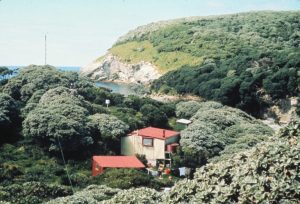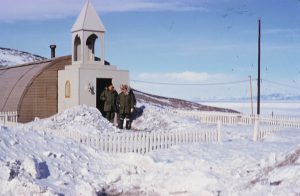 Year 1956. The first Chapel at McMurdo Station was built in 1956 by pious U.S. Navy Seabees. On May 6,1956, the Chapel was consecrated to Our Lady of the Snows and the bell consecrated to Saint Dismas, the good thief.(see Our Lady of the Snow … Old memories by Patrick McCormick, a proud Antarctic veteran – W.A.P. (waponline.it).
Year 1956. The first Chapel at McMurdo Station was built in 1956 by pious U.S. Navy Seabees. On May 6,1956, the Chapel was consecrated to Our Lady of the Snows and the bell consecrated to Saint Dismas, the good thief.(see Our Lady of the Snow … Old memories by Patrick McCormick, a proud Antarctic veteran – W.A.P. (waponline.it).
At the beginning, it was also known as Chapel of St. Dismas (see the life od St. Dismas at the bottom of this page) after the good thief. Originally there were neither plans nor materials requisitioned to build a chapel, so, they “found” extra materials and built it on their own time. Father Ron O’Gorman of the Christchurch Diocese traveled on an icebreaker and was the first New Zealand priest to celebrate Mass in Antarctica, Dec. 25, 1957.
In preparation for Antarctic research to be conducted during the International Geophysical Year (1957-1958), U.S. Naval Construction Battalion personnel (Seabees) began building McMurdo Station during the 1955-1956 austral summer. The original plans for the station did not include a chapel; instead, religious services were to be held in the station mess hall.
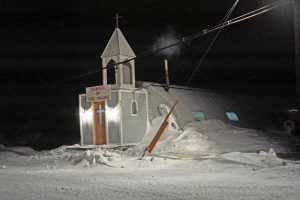 However, according Admiral George Dufek, who commanded Deep Freeze I, “As the construction of the buildings at McMurdo progressed a mysterious pile of lumber, planks, nails, Quonset hut sections, and assorted materials began to accumulate on a knoll overlooking the camp.” Just few years later the Chapel was renamend as Chapel of the Snow (aka Blue Chapel . Picture aside show how the Chapel was in 1963 and Blue Chapel 1968.
However, according Admiral George Dufek, who commanded Deep Freeze I, “As the construction of the buildings at McMurdo progressed a mysterious pile of lumber, planks, nails, Quonset hut sections, and assorted materials began to accumulate on a knoll overlooking the camp.” Just few years later the Chapel was renamend as Chapel of the Snow (aka Blue Chapel . Picture aside show how the Chapel was in 1963 and Blue Chapel 1968.
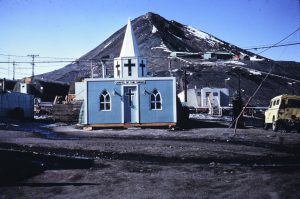 The Chaplain, Father John C. Condit, and volunteers from the construction battalion gradually gathered enough materials to build what was to become the first church ever erected in Antarctica. All of the work was done by volunteers after their daily duties were finished. Admiral Dufek also observed that “The men, after a hard day’s work, would drift over to the church site. Before the main camp was finished a tidy neat church with a steeple was to stand on a ridge overlooking the camp. Later it even had a bell, procured from a small gasoline tanker.” When the Chapel was completed, Father Condit had the world’s most southern parish.
The Chaplain, Father John C. Condit, and volunteers from the construction battalion gradually gathered enough materials to build what was to become the first church ever erected in Antarctica. All of the work was done by volunteers after their daily duties were finished. Admiral Dufek also observed that “The men, after a hard day’s work, would drift over to the church site. Before the main camp was finished a tidy neat church with a steeple was to stand on a ridge overlooking the camp. Later it even had a bell, procured from a small gasoline tanker.” When the Chapel was completed, Father Condit had the world’s most southern parish.
The Chapel of the Snows at McMurdo Station was destroyed by fire on 22 August 1978. No one was injured, but the chapel and almost all its contents were a total loss. For 22 years this simple building provided a place of worship for personnel not only at McMurdo Station (WAP USA-22) but also from nearby Scott Base (WAP NZL-Ø1).
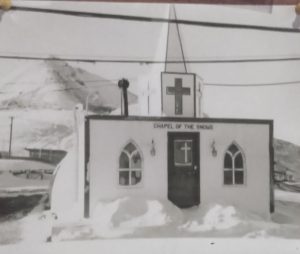 Year 1979. On Easter Sunday 1979, the second Chapel or the Temporary Chapel was dedicated.
Year 1979. On Easter Sunday 1979, the second Chapel or the Temporary Chapel was dedicated.
Here some details: A refurbishing of McMurdo Station was planned by the National Science Foundation, and a new chapel was included in the design. To replace the burned Chapel, volunteers converted a quonset Hut near the station’s main building. While they worked to complete this temporary Chapel, the Chalet served as the site for the community’s religious services. However, this building, which normally houses NSF and contractor offices, could not accommodate both Sunday morning services and daily administrative activities during the summer season.
The Temporary chapel built by the community was left abandoned until it too, suffered a fiery demise during a condition 1 storm on 18 May 1991. It caught fire and was totally destroyed.
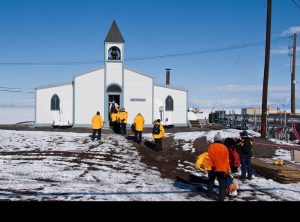 Year 1989. The third chapel was designed to replace the previous temporary one in use as such after the 1978 fire until. The new building was dedicated in 1989.
Year 1989. The third chapel was designed to replace the previous temporary one in use as such after the 1978 fire until. The new building was dedicated in 1989.
Although the original chapel and the temporary building were built entirely by volunteers, the new building was constructed as part of the National Science Foundation’s plan to refurbish the McMurdo Station. The 2,016-square-foot wood structure contains office space, a central worship area that normally seats 63, and McMurdo’s only organ. Materials to complete the building were salvaged from older structures that were ripped down during the several-year rebuilding of the station.
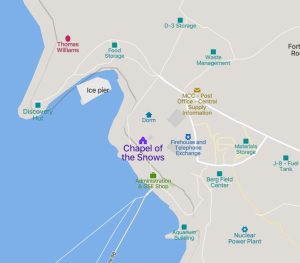 McMurdo Station once again has a permanent place of worship. To commemorate this occasion, approximately 80 people gathered on Sunday, 29 January 1989 to dedicate the new Chapel of the Snows, which is the third chapel to be raised at the station.
McMurdo Station once again has a permanent place of worship. To commemorate this occasion, approximately 80 people gathered on Sunday, 29 January 1989 to dedicate the new Chapel of the Snows, which is the third chapel to be raised at the station.
The current Capel, the Chapel of the Snows, is the third in the history of McMurdo. It is the southernmost house of worship in the world.
See also: Churches in Antarctica (oceanwide-expeditions.com)
The Life of Saint Dismas
We don’t know much about the life of Dismas. Most of it is the subject of legend. A popular medieval legend surrounding Dismas’ life is:
While the Holy Family was fleeing to Egypt, they stopped to spend the night in a cave. Living in the cave was a family with a son about the same age as Jesus. Sadly, the infant had leprosy, which was a painful and contagious disease. Mary told the mother of the child to bathe him in the water she had just used to wash our Savior. The mother did as Mary instructed and instantly cured the child. The two boys grew up and learned the trade of their fathers. Jesus preached and went about His ministry. While the other became a thief, like his father. The two men met again on Calvary. One of the thieves, traditionally called Gestas, mocked Jesus claiming if He really was the Son of God he could save Himself and them as well.
But Dismas rebuked him saying that they were thieves and received their punishment justly but Jesus was falsely accused. Then turning to Jesus he apologized and asked, ” Lord, please remember me when you go into your kingdom.” Jesus replied, “Today you will be with Me in Paradise.”
Dismas died around 33 in the year of Our Lord.
Saint Dismas’ Feast Day is March 25 and he is the patron of prisoners (especially condemned) and repentant thieves.
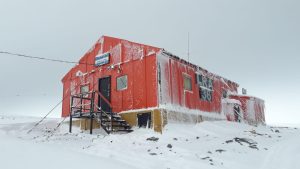 WAP has received some notes sent by Alejandro LU8YD the operator at Esperanza Base (WAP ARG-Ø4) in February and March 2023 and at LU4ZS Marambio Base (WAP ARG-21) in April 2023.
WAP has received some notes sent by Alejandro LU8YD the operator at Esperanza Base (WAP ARG-Ø4) in February and March 2023 and at LU4ZS Marambio Base (WAP ARG-21) in April 2023.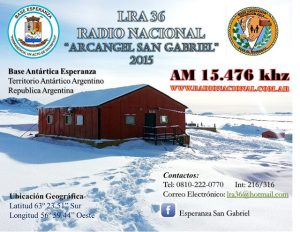 operation from Antarctica in bands and modes with extraordinary results on 6 meters and perhaps the first to operate on FT8, FT4 and FM on 29 MHz in addition to the new 60 meter band. All the hamradio operation are performed from inside the building of LRA36 Radio Nacional Arcangel San Gabriel, using its rombic antenna
operation from Antarctica in bands and modes with extraordinary results on 6 meters and perhaps the first to operate on FT8, FT4 and FM on 29 MHz in addition to the new 60 meter band. All the hamradio operation are performed from inside the building of LRA36 Radio Nacional Arcangel San Gabriel, using its rombic antenna 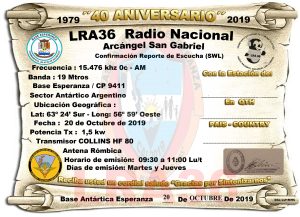 and FT8. The LU1ZV activations have the support of the “Uniendo Voces” a project of the National University of Quilmes (Buenos Aires province).
and FT8. The LU1ZV activations have the support of the “Uniendo Voces” a project of the National University of Quilmes (Buenos Aires province).
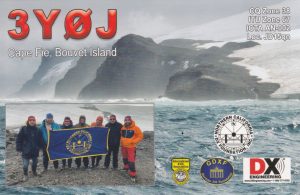 Kapp Fie , 54° 27′ South, 3° 28′ East, at the South East side of Bouvetøya (Bouvet Island), has been issued a reference
Kapp Fie , 54° 27′ South, 3° 28′ East, at the South East side of Bouvetøya (Bouvet Island), has been issued a reference 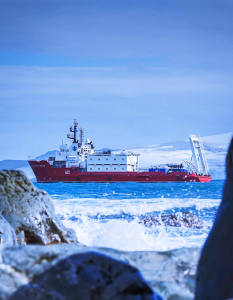 The Bulgarian Polar Research Vessel “Sv. Sv. Kiril i Metodiy (RSV-421)” is owned by a consortium consisting of the Naval Academy, the St Kliment Ohridski University of Sofia and the Bulgarian Antarctic Institute. The Sv. Sv. Kiril i Metodii was ceremoniously christened and commissioned into the Bulgarian Navy inventory on July 27, 2021.
The Bulgarian Polar Research Vessel “Sv. Sv. Kiril i Metodiy (RSV-421)” is owned by a consortium consisting of the Naval Academy, the St Kliment Ohridski University of Sofia and the Bulgarian Antarctic Institute. The Sv. Sv. Kiril i Metodii was ceremoniously christened and commissioned into the Bulgarian Navy inventory on July 27, 2021.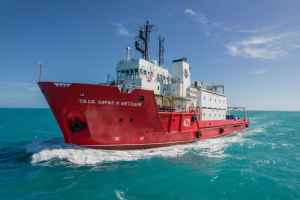 Now the Polar ship is docked at Bulgarian port city of Varna (on the Black Sea) after fully completing its participation in the 31st Bulgarian Antarctic Expedition to Livingston Island, Antarctica
Now the Polar ship is docked at Bulgarian port city of Varna (on the Black Sea) after fully completing its participation in the 31st Bulgarian Antarctic Expedition to Livingston Island, Antarctica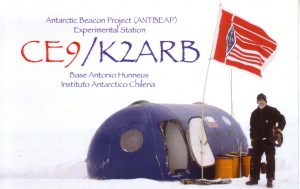 The Base is located at 80°18’ South, 81°20’ West, just 1 km from the Patriot Hills Camp (
The Base is located at 80°18’ South, 81°20’ West, just 1 km from the Patriot Hills Camp ( Prof. Lyubomir Ivanov is the National Representative of Bulgaria to SCAR SCAGI and Chairman of the Antarctic Place-names Commission at Ministry of Foreign Affairs-Republic of Bulgaria. Lyubo is Chairman, Toponymic Board at National Centre for Polar Studies as well.
Prof. Lyubomir Ivanov is the National Representative of Bulgaria to SCAR SCAGI and Chairman of the Antarctic Place-names Commission at Ministry of Foreign Affairs-Republic of Bulgaria. Lyubo is Chairman, Toponymic Board at National Centre for Polar Studies as well.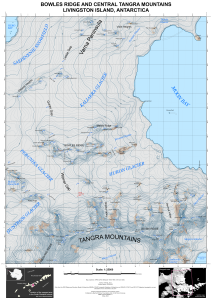 Hard copies of the map could be purchased from
Hard copies of the map could be purchased from  Year 1956
Year 1956 However, according Admiral George Dufek, who commanded Deep Freeze I, “As the construction of the buildings at McMurdo progressed a mysterious pile of lumber, planks, nails, Quonset hut sections, and assorted materials began to accumulate on a knoll overlooking the camp.” Just few years later the Chapel was renamend as Chapel of the Snow (aka Blue Chapel . Picture aside show how the Chapel was in 1963 and Blue Chapel 1968.
However, according Admiral George Dufek, who commanded Deep Freeze I, “As the construction of the buildings at McMurdo progressed a mysterious pile of lumber, planks, nails, Quonset hut sections, and assorted materials began to accumulate on a knoll overlooking the camp.” Just few years later the Chapel was renamend as Chapel of the Snow (aka Blue Chapel . Picture aside show how the Chapel was in 1963 and Blue Chapel 1968. The Chaplain, Father John C. Condit, and volunteers from the construction battalion gradually gathered enough materials to build what was to become the first church ever erected in Antarctica. All of the work was done by volunteers after their daily duties were finished. Admiral Dufek also observed that “The men, after a hard day’s work, would drift over to the church site. Before the main camp was finished a tidy neat church with a steeple was to stand on a ridge overlooking the camp. Later it even had a bell, procured from a small gasoline tanker.” When the Chapel was completed, Father Condit had the world’s most southern parish.
The Chaplain, Father John C. Condit, and volunteers from the construction battalion gradually gathered enough materials to build what was to become the first church ever erected in Antarctica. All of the work was done by volunteers after their daily duties were finished. Admiral Dufek also observed that “The men, after a hard day’s work, would drift over to the church site. Before the main camp was finished a tidy neat church with a steeple was to stand on a ridge overlooking the camp. Later it even had a bell, procured from a small gasoline tanker.” When the Chapel was completed, Father Condit had the world’s most southern parish. Year 1979
Year 1979 Year 1989
Year 1989 McMurdo Station once again has a permanent place of worship. To commemorate this occasion, approximately 80 people gathered on Sunday, 29 January 1989 to dedicate the new Chapel of the Snows, which is the third chapel to be raised at the station.
McMurdo Station once again has a permanent place of worship. To commemorate this occasion, approximately 80 people gathered on Sunday, 29 January 1989 to dedicate the new Chapel of the Snows, which is the third chapel to be raised at the station.